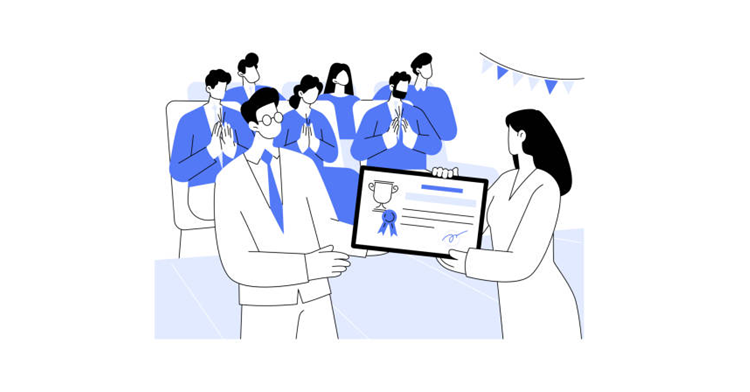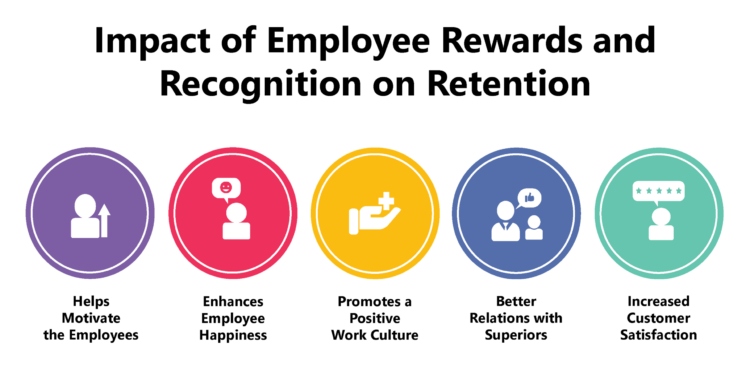1. Employee rewards and recognition programs are crucial in retaining top talent, as they fulfill employees’ need for recognition and respect beyond financial incentives.
2. Recognition motivates employees, enhances their overall happiness, fosters a positive work culture, and improves their relationships with superiors, ultimately contributing to higher retention rates.
3. Satisfied and appreciated employees are more likely to stay with the organization, leading to improved performance, increased customer satisfaction, and overall business growth.
4. Effective recognition programs help reduce turnover by fostering loyalty, team bonding, and a supportive work environment.
Most organizations today struggle to find an effective solution for employee retention. Employee turnover results in the loss of money, time, and effort, and disrupts the organization’s smooth functioning. Therefore, organizations should assess the impact of employee rewards and recognition on employee retention and implement appropriate programs accordingly.
Most organizations are often unaware of the deep connection between employee rewards and recognition and retention.

It is a common misconception that employees seek only good salaries, benefits, and other financial incentives from their jobs.
Hence, many organizations focus only on offering financial benefits for their top performers but are still unable to retain them.
This is because most high-performing employees crave recognition and respect as much as they seek financial benefits.
For such employees, rewards and recognition offer a sense of self-fulfillment, motivating them to perform at their best.

That is why organizations without proper rewards and recognition programs may struggle to retain them for long.
As mentioned, employees need to feel valued and appreciated for contributing to organizational growth.
A proper employee recognition program enhances the overall engagement levels of employees:
Here is why employee rewards and recognition have a significant impact on employee retention:
1. Motivates Employees
2. Enhances Employee Happiness
3. Promotes a Positive Work Culture
4. Creates Better Relations with Superiors
5. Increases Customer Satisfaction


Being recognized for their efforts, initiatives, and skills motivates employees to repeat that behavior.
It encourages them to improve their performance further to receive more rewards and recognition.
So, being valued for their work by the organization develops a sense of loyalty among the employees towards the organization.
Hence, loyal employees are less likely to leave the organization for other opportunities.

When employees feel that their hard work is not going unnoticed, they tend to feel happier and satisfied at work.
As a result, they become more willing to take on challenging tasks with a positive mindset and can raise their performance levels.
Hence, most importantly, happy and satisfied employees are less likely to seek employment elsewhere.

Employees who feel happy and satisfied in their workplace tend to develop a positive and friendly work environment.
So, it helps create a fun-filled work culture based on mutual trust and understanding.
Employees develop a strong sense of team bonding and comfort.
Such employees feel less need to leave and work with another organization.
The rewards program thus helps improve employee loyalty and create a positive work culture with healthy peer competition.

One primary reason employees leave an organization is their poor bonding with their superiors.
However, when employees are recognized for their efforts, they feel assured of the support and appreciation of their superiors.
Therefore, it helps the employees to view their superiors from an entirely different and more positive perspective.
So, supervisors can better utilize the skills and productivity of employees and appreciate them openly.
Additionally, it can foster a better mutual understanding and trust between employees and their superiors.

Employees who are appreciated for their work tend to put more effort into improving customer satisfaction.
Rewards and recognition result in a significant improvement in their performance and efficiency while dealing with customers.
Moreover, it helps improve the trust and camaraderie of customers and employees, which leads to higher business growth and profitability.
Hence, such employees are often treated as brand ambassadors for the organizations and can help attract more customers.
They can also help attract top talent for their organizations and retain existing talent.
While salary, financial perks, and benefits play a vital role in attracting top talent, their retention in the organization depends significantly on the effectiveness of the employee rewards and recognition program – how the efforts and contributions of employees are recognized and rewarded.

Lead author: Sagar Chaudhuri, the Co-Founder and CEO of HiFives. He is an HR Tech Evangelist with over 25 years of experience in both corporate and entrepreneurial settings. Previously, Sagar has held leadership roles with companies such as Genpact, Infosys, and ICICI Bank. He has an engineering degree from IIT Kharagpur and an MBA from IIM Lucknow. Connect on LinkedIn
To stay updated on the latest HiFives blogs, follow us on Twitter (@MyHiFives)